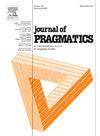Automatic behaviour analysis reveals links between facial expression and speech acts’ illocutionary point, strength, and valence
IF 1.7
1区 文学
0 LANGUAGE & LINGUISTICS
引用次数: 0
Abstract
There is abundant literature indicating that, beyond its role in emotional communication, facial behaviour could be essential in the way individuals carry out performative functions of speech. Using speech acts theory, we formalised three ways facial signals could relate to verbal utterances: 1) by authenticating the illocutionary point of statements, 2) by authenticating the valence of the mental states underlying speech acts, and 3) by supporting attempts at modulating the strength of a speech act's illocutionary force. We investigated these relationships in an observational case study of a public hearing of the U.S. Senate. Overall, facial behaviour was more intense during performative than during declarative speech acts and we observed a negative relationship between facial expressivity and the illocutionary strength of speech acts. Facial behaviour was also related to the valence of speech acts, albeit to a lesser extent. While we observed multiple links between individual facial Action Units and speech acts, the pattern of results does not indicate a unique set of associations between specific facial movements and specific properties of speech acts. The present study supports the idea that facial behaviour plays a role in the pragmatics of social interaction in that it could be used by speakers to show the authenticity of their communicative intentions and to modulate the illocutionary force of verbal statements. It also suggests that the cognitive and emotional states underlying the production of speech acts could share structural and functional elements with the appraisal processes involved in the production of facial behaviour.
自动行为分析揭示了面部表情与言语行为的言外点、强度和效价之间的联系
有大量的文献表明,除了在情感交流中的作用,面部行为在个体执行言语的表现功能方面可能是必不可少的。使用言语行为理论,我们形式化了面部信号与言语话语相关的三种方式:1)通过验证陈述的言外点,2)通过验证言语行为背后的心理状态的效价,以及3)通过支持调节言语行为的言外力强度的尝试。我们在美国参议院公开听证会的观察性案例研究中调查了这些关系。总体而言,在表演性言语行为中,面部表情比陈述性言语行为更强烈,我们观察到面部表情与言语行为的言外力量之间存在负相关。面部行为也与言语行为的效价有关,尽管程度较低。虽然我们观察到个体面部动作单元和语言行为之间的多重联系,但结果的模式并没有表明特定的面部运动和语言行为的特定属性之间存在一组独特的关联。本研究支持面部行为在社会互动的语用学中发挥作用的观点,因为它可以被说话者用来显示其交际意图的真实性,并调节言语陈述的言外力量。研究还表明,言语行为产生的认知和情绪状态可能与面部行为产生的评估过程具有相同的结构和功能要素。
本文章由计算机程序翻译,如有差异,请以英文原文为准。
求助全文
约1分钟内获得全文
求助全文
来源期刊

Journal of Pragmatics
Multiple-
CiteScore
3.90
自引率
18.80%
发文量
219
期刊介绍:
Since 1977, the Journal of Pragmatics has provided a forum for bringing together a wide range of research in pragmatics, including cognitive pragmatics, corpus pragmatics, experimental pragmatics, historical pragmatics, interpersonal pragmatics, multimodal pragmatics, sociopragmatics, theoretical pragmatics and related fields. Our aim is to publish innovative pragmatic scholarship from all perspectives, which contributes to theories of how speakers produce and interpret language in different contexts drawing on attested data from a wide range of languages/cultures in different parts of the world. The Journal of Pragmatics also encourages work that uses attested language data to explore the relationship between pragmatics and neighbouring research areas such as semantics, discourse analysis, conversation analysis and ethnomethodology, interactional linguistics, sociolinguistics, linguistic anthropology, media studies, psychology, sociology, and the philosophy of language. Alongside full-length articles, discussion notes and book reviews, the journal welcomes proposals for high quality special issues in all areas of pragmatics which make a significant contribution to a topical or developing area at the cutting-edge of research.
 求助内容:
求助内容: 应助结果提醒方式:
应助结果提醒方式:


